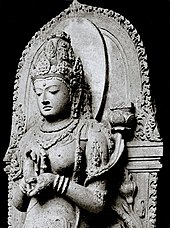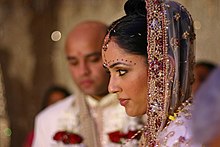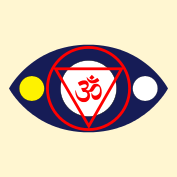Bindi (decoration)

Abindi(fromSanskritbindúmeaning "point, drop, dot or small particle" )[1][2]is a coloured dot or, in modern times, astickerworn on the centre of the forehead, originally by Hindus, Jains and Buddhists from theIndian subcontinent.
A bindi is a bright dot of some colour applied in the centre of the forehead close to theeyebrowsor in the middle of the forehead that is worn in the Indian subcontinent (particularly amongst Hindus inIndia,Nepal,Bhutan,andSri Lanka)[3]and Southeast Asia amongBalinese,Javanese,Sundanese,Malaysian,Singaporean,Vietnamese,andMyanmarHindus. A similar marking is also worn by babies and children inChinaand, as in the Indian subcontinent and Southeast Asia, represents the opening of thethird eye.[4]InHinduism,Buddhism,andJainismthe bindi is associated with theajnachakra,andBindu[5]is known as thethird eyechakra.Binduis the point or dot around which themandalais created, representing the universe.[6][7]The bindi has a religious, historical and cultural presence in the region ofIndiaand with the Hindu,Indian diasporaaround the world.[8][9]
Religious significance
[edit]Traditionally, the area between the eyebrows (where the bindi is placed) is said to be the sixthchakra,ajna,the seat of "concealed wisdom". The bindi is said to retain energy and strengthen concentration.[10]The bindi also represents thethird eye.[11] TheNasadiya Suktaof the Rig Veda, the earliest known Sanskrit text, mentions the wordBindu.[12]

TheAjnais symbolised by asacred lotuswith two petals, and corresponds to the colours violet, indigo or deep blue, though it is traditionally described as white. It is at this point that the two sides NadiIda (yoga)and Pingala are said to terminate and merge with the central channel Sushumna, signifying the end of duality, the characteristic of being dual (e.g.lightanddark,ormaleandfemale). Theseed syllablefor this chakra is the syllable OM, and the presiding deity isArdhanarishvara,who is a half male, half female Shiva/Shakti. The Shakti goddess of Ajna is called Hakini. In metaphysics,Binduis considered the dot or point at which creation begins and may become unity. It is also described as "the sacred symbol of the cosmos in its unmanifested state".[3][6]Bindu is the point around which themandalais created, representing the universe.[7]Ajna's key issues involve balancing the higher and lower selves and trusting inner guidance. Ajna's inner aspect relates to the access of intuition. Mentally, Ajna deals with visual consciousness. Emotionally,Ajnadeals with clarity on an intuitive level.[5]

In Hinduism, Buddhism, and Jainism, bindi is associated with Ajna Chakra andBindu.[5]Divinities in these religions are typically depicted withBhrumadhyaBindu,in meditative pose with their eyes nearly closed show the gaze focused between eyebrows, other spot being the tip of the nose—Naasikagra. The very spot between the eyebrows known as Bhrumadhya is where one focuses one's sight, so that it helps concentration.[7]

The bindi has multiple meanings:
- Archaeology has yielded clay female figurines from the Indus Valley with red pigment on the forehead and hair parting. It is unclear whether this held any religious or cultural significance.[13]
- In Hinduism, the colour red represents honour, love, and prosperity, hence bindis are worn to symbolise these qualities after marriage in particular.[14]
- In meditation, the point between the eyebrows (Bhrumadhya) is where one focuses one's sight, to help concentration. Most images of Hindu, Jain or Buddhist divinities in meditative poses with their eyes nearly closed show the gaze focused between the eyebrows (another spot being the tip of the nose—naasikagra)
- Swami Muktananda writes that "auspiciousKumkumaor sandalwood paste is applied (between the eyebrows) out of respect for the inner Guru. It is the Guru's seat. There is a chakra (centre of spiritual energy within the human body) here called Ajna chakra, meaning 'Command centre'. Here is received the Guru's command to go higher in Sadhana (spiritual practice) to the 'Sahasraar' (seventh and final chakra) which leads to Self-realisation. The flame seen at the eyebrow is called 'Guru Jyoti'. "[15]
- The encyclopaedicDictionary of Yogareports that this 'Ajna Chakra' is also called the 'Third eye'. This centre is connected with the sacred syllable 'Om' and presiding, is 'Parashiva'. On activating this centre, the aspirant overcomes 'Ahankāra' (the ego or sense of individuality), the last stop on the path of spirituality.[16]
Despite having a strong religious origin and significance, some Muslim women from South Asia choose to wear the bindi as a fashion accessory. The Islamic Research Foundation, located in India, has had to state "wearing a bindi or mangalsutra is a sign of Hindu women. The traditional bindi still represents and preserves the symbolic significance that is integrated into Indian mythology in many parts of India."
Traditional application method
[edit]
A traditional bindi is red or maroon in colour. A pinch of vermilion powder is applied with a ring-finger to make a dot. A small annular disc aids application for beginners. First, a sticky wax paste is applied through the empty centre of the disc. This is then covered with kumkum or vermilion and then the disc is removed to get a round bindi. Various materials such aslac,sandal, 'aguru',mica,'kasturi', kumkum (made of red turmeric) andsindoorcolour the dot. Saffron ground together with'kusumba' flowercan also work.[17]Traditionally they are green in colour with a red dot in the middle.[18]The bindi is no longer restricted in colour or shape.[19][20]

Historically, the ornamental bindi spangle consists of a small piece of lac over which is smeared vermilion, while above it a piece of mica or thin glass is fixed for ornament. Women wore large spangles set in gold with a border of jewels if they could afford it. The bindi was made and sold by lac workers known asLakhera.[21]In Hinduism, it's part of theSuhāgorlucky trousseauat marriages and is affixed to the girl's forehead on her wedding and thereafter always worn.[20]Unmarried girls optionally wore small ornamental spangles on their foreheads. A widow was not allowed to wear bindi or any ornamentation associated with married women.[20]In modern times, self-adhesive bindis are available in various materials, usually made of felt or thin metal and adhesive on the other side. These are simple to apply, disposable substitutes for older lac tikli bindis. Sticker bindis come in many colours, designs, materials, and sizes.

There are different regional variations of the bindi. In Maharashtra a largecrescent moonshaped bindi is worn with a smaller black dot underneath or above, associated withChandrabinduandBindu chakrarepresented by crescent moon, they are commonly known asChandrakorin this region, outside Maharashtra they are popularly known asMarathi bindi.In Bengal region a large round red bindi is worn, brides in this region are often decorated withAlpanadesign on forehead and cheeks, along with bindi. In southern India a smaller red bindi is worn with a white tilak at the bottom, another common type is a redtilakshaped bindi. In Rajasthan the bindi is often worn round. Longtilakshaped bindi are also common, as well as the crescent moon on some occasions. Decorative bindis have become popular among women in South Asia, regardless of religious background. Bindis are a staple and symbolic for women in the Indian subcontinent.[22]
In addition to the bindi, in India, avermilionmark in the parting of the hair just above the forehead is worn by married women as a symbol of life-long commitment to their husbands. During all Hindu marriage ceremonies, the groom applies sindoor in the part in the bride's hair.[23]
Apart from their cosmetic use, bindis have found a modern medical application in India. Iodine patch bindis have often been used among women in north-west Maharashtra to battle iodine deficiency.[24]
Related customs in other Asian regions
[edit]
InSoutheast Asia,bindis are worn by theBalinese,Javanese,andSundanese peopleofIndonesia.For example, bindis are often worn by brides and grooms inJavaand other parts ofIndonesia,regardless of their religious beliefs.
The Indonesian practice of wearing a bindi originated from the cultural influence brought about by theIndianizedHindu kingdoms that once ruled Indonesia. Historically, other Indianized kingdoms inSoutheast Asiaalso took part in this practice.
Chandrakor in Maharashtrian Culture
[edit]The Maharashtrian bindi is a half-moon-shaped bindi with a little dot underneath it. These bindis indicate a woman’s marital status. They go well with traditional Marathi sarees and may be worn by women with any type of face form. Also called Chandrakor.[25]
Teep
[edit]
Teeportip,similar to bindis, are part ofBengali cultureand women inWest Bengal, IndiaandBangladesh,irrespective of their religion, adorn themselves with teeps as an ethnic practice.[26][27][28][29]By the 18th century the use of teeps had become very common.[30]It's popular in celebrations likeDurga Puja,Pohela Boishakh,Pohela Falgun,Eid al-Fitr,Eid al-Adhaand other occasions.
Bengali Muslimsapprove wearing the teep as a cultural representation as long as there's no intention of imitating the bindi culture of other religions. Depending on the occasion the colours of teep change, such as red and white for Pohela Boishakh, green, orange and yellow forPohela Falgun,blue and white forBarsha Mangal,brown and mustard colour forNabanna,purple and pink for Eid Al Fitr and black forInternational mother Language Day,Eid Al Adha,red and green forIndependence DayandVictory Day.Bengali Muslim brideswearing "kalka tip" on their forehead is an old tradition of Bangladesh.[31]
Bindis in Pakistan
[edit]InSindh,some Muslim Sindhi women apply a black dot or line by "Kajjal or Surmo (kohl) "on the forehead and chin, and sometimes three dots or lines around eyes as part of historic Indian traditions that have continued post-Partition. As anamuletbelieved to protect against evil-eye, these dots are called Tikro or Tilk (singular), or Tikra (plural).[32]
Like in India, in Sindh, when a child is born, black dots/marks and lines are drawn on their facea. In modern times, stick-on bindiyas of different shapes and designs have become very common in rural Sindh, and are applied by both Muslims and Hindus. However, this is in decline as it is considered to be appropriately used by Sindhi Hindus only.
Back in time in Sindh the brides were applied many dots of "Tira" (moles) drawn upon their face and lips with needles dipped inantimonyand other colouring matters.[33]
The type of forehead tattoo called Khaal or Sheen Khal was also common among Afghan andPashtunwomen,[34][35]although it is no longer done for religious reasons. As in Sindh, dots are made using kohl or other material. Bindis are also used bySaraikiand someBalochtribal women of Pakistan. However, manyMuhajirandPunjabiconsider the use of bindis to be un-Islamic. Due to this, the use of bindis has declined in many urban areas of Pakistan.
Modern use
[edit]
Bindis are sometimes worn purely for decorative purpose or style statement without any religious or cultural affiliation.[37]Decorative and ornamental bindis were introduced to other parts of the world by immigrants from the Indian subcontinent.[38]International celebrities such asGwen Stefani,Julia Roberts,[39]Madonna,[40]Selena Gomezand many others have been seen wearing bindis.[41]The appropriateness of such uses has been disputed. Reacting to Gomez wearing a bindi while singing her song "Come and Get It",Hindu leaderRajan Zedsaid that the bindi has religious significance and should not be used as a fashion accessory,[42]but Indian actressPriyanka Choprapraised Gomez's choice as "an embrace of Indian culture".[43]Additionally, several rappers have adopted jewelled bindis, most notablyLil Uzi Vert,who debuted a $24 million pink diamond bindi in February 2021. They were inspired byLil Bwho wore a diamond bindi in 2012.[44]

Alternative terms
[edit]A bindi can also be called:[45]
- PhotorPhut(literally meaning a small pressing mark) inAssamese
- Tip(literally meaning "a pressing" ) inBengali
- Tikuli(literally meaning "a smalltika") inMadhyadeshi areas
- Chandlo(literally meaning moon shape) inGujarati
- TilakainHindi
- TikainNepali
- KunkumaorBottuorTilakainKannada
- TilakayainSinhala
- TikliinKonkani
- KunkooorTikaliinMarathi
- TikiliinOdia
- BindiinPunjabimeaning long red mark
- PottuorKunkumamorTilakaminTamilandMalayalam
- Bottu,Kunkuma, orTilakaminTelugu
- TikliinMaithili
- TyokinKashmiri
- TilkodiinSindhi
See also
[edit]- Huadian,a traditional Chinese forehead decoration
- Thirunamam
- Tilaka
- Urna
- Vibhuti,sacred ash applied across the forehead
References
[edit]- ^"History and Etymology for bindi".Merriam-Webster.Retrieved16 January2022.
borrowed from Hindibindī,literally, "dot, mark" (or a cognate Indo-Aryan word), going back to the Middle Indo-Aryan and Sanskrit stembindu-"drop, spot," it's worn by Hindu, Buddhist, Jaina and some Sikhs
- ^"Bindi etymology".Etymologeek.Retrieved16 January2022.
English word bindi comes from Hindi बिंदी
- ^abKhanna 1979: p. 171
- ^Xiaoou, Yu (10 September 2014)."Guidelines for school entrance in ancient China".ChinaCulture.org.Retrieved16 February2018.
- ^abcdMercier (2007). p. 267.
- ^abSwami Ranganathananda(1991).Human Being in Depth: A Scientific Approach to Religion.SUNY Press. p. 21.ISBN0791406792.
- ^abcShakya, pp. 82–83
- ^Southeast Asia: A Historical Encyclopedia, from Angkor Wat to East Timor,byKeat Gin Ooip. 642
- ^Hindu-Buddhist Architecture in Southeast Asiaby Daigorō Chihara p. 226
- ^Das, Subhamoy."Bindi: The Great Indian Forehead Art".Archived fromthe originalon 2 February 2017.Retrieved16 February2009.
- ^"Couples Fuel India's Vibrant Art Scene".The New York Times.13 October 2011.Retrieved20 October2011.
- ^"nasadiya-suktha-and-purusha-suktha".21 September 2012.
- ^M. Kenoyer, Jonathan (1998).Ancient Cities of the Indus Valley Civilization(1st ed.). Oxford University Press. p. 186.ISBN0195779401.
- ^Pintchman, Tracy (2007).Women's Lives, Women's Rituals in the Hindu Tradition.Oxford. pp.90–97.ISBN978-0195177060.
- ^From Finite to Infinite,by Swami Muktananda, SYDA Foundation, S. Fallsburg, New York, 1989, pp. 88–89
- ^Encyclopedic Dictionary of Yoga,by Georg Fuerstein, Paragon House Publishers, New York, 1990, p. 15
- ^"Bindi: The Great Indian Forehead Art".About.com.Archived fromthe originalon 2 February 2017.Retrieved9 January2012.
- ^Bahadur, Om Lata (1996).The book of Hindu festivals and ceremonies(3rd ed.). New Delhi: UBS Publishers Distributors ltd. p.168.ISBN81-86112-23-5.
- ^Khadi and Village Industries Commission, Government of India
- ^abcParvesh Handa, "Home Beauty Clinic", Pustak Mahal,ISBN81-223-0099-5
- ^"The Tribes and Castes of the Central Provinces of India—Volume IV".
- ^Priyabala Shah (April 1986) "Tilaka: Hindu marks on the forehead", p.88
- ^Gwynne, Paul (2009).World Religions in Practice: A Comparative Introduction.Maiden, MA: Blackwell Publishing.ISBN9781444360059.
- ^Dhar, Shobha (11 April 2015)."Iodine bindis for tribal women to fight deficiency".TNN. The Times of India.Retrieved25 July2015.
- ^sheetal (13 September 2022)."Types of Bindi".Medium.Retrieved16 July2024.
- ^চৌধুরী, মধুমন্তী (22 September 2015)."পুজোর বাজারে সাবেকি টিপ".Anandabazar Online.Retrieved25 December2023.
- ^"Teep".
- ^P.K.BALACHANDRAN (17 April 2019)."Bangladesh Asserts its Bengali Identity in Mass Celebration of Pohela Boishak".www.thecitizen.in.Retrieved11 June2023.
- ^"টিপটপ টিপ".www.kalerkantho.com.March 2020.Retrieved11 June2023.
- ^ইসলাম, সায়েদুল (2 April 2022)."বাঙালি নারীদের মধ্যে টিপ পরার প্রচলন শুরু হলো যেভাবে".BBC.Retrieved25 December2023.
- ^Kalka.Banglapedia.
- ^"ٽڪو2: (Sindhianaسنڌيانا)".www.encyclopediasindhiana.org(in Sindhi).Retrieved25 January2024.
- ^Burton, Sir Richard Francis (1851).Sindh, and the Races that Inhabit the Valley of the Indus.W. H. Allen.
- ^"Khaal, The Tattoo of Afghan Womxn".Her Culture.24 May 2021.Retrieved11 June2023.
- ^Khan, Moxet (25 November 2020)."Sheen Khal / blue tattoo are the Beauty Marks for Pakhtun females".Pukhtoogle.Retrieved11 June2023.
- ^"Svami Sadananda Dasa: Disciple of Bhaktisiddhanta Sarasvati and Guru of Vamandas (Walther Eidlitz)".sadananda.com.
- ^Khu phố Little India ở Artesia,Nguoi Viet Online,11 November 2011, Retrieved 22 November 2011
- ^Juventud organiza un mercadillo solidario a beneficio de la Fundación Vicente Ferrer,elperiodic.com,17 November 2011. Retrieved 22 November 2011
- ^"'Pretty Woman' in temple upset ".BBC News.23 September 2009.Retrieved26 April2010.
- ^"Try a bindi now with Western wear".Punjab Newsline.6 October 2011. Archived fromthe originalon 30 March 2012.Retrieved20 October2011.
- ^"Should Selena Gomez apologize for wearing a bindi at the MTV Movie".17 April 2013.
- ^Sieczkowski, Cavan (16 April 2013)."Selena Gomez Bindi: Hindu Leaders Demand Apology For MTV Movie Awards Costume".Huffington Post.Retrieved25 September2015.
- ^DelliCarpini, Gregory Jr. (22 May 2013)."Selena Gomez's Bindi Styling: Offensive? Bollywood Star Priyanka Chopra Talks About the Star's Usage".Billboard.Retrieved25 September2015.
- ^"Lil Uzi Vert's $24 Million Forehead Diamond Was Inspired by Lil B".exclaim.ca.Retrieved17 February2021.
- ^"Dazzling bindis".MSN India.10 October 2011. Archived fromthe originalon 12 October 2011.Retrieved20 October2011.


